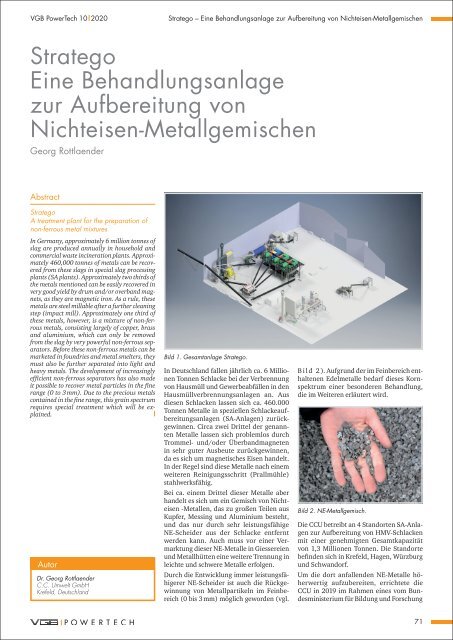VGB POWERTECH 10 (2020) - International Journal for Generation and Storage of Electricity and Heat
VGB PowerTech - International Journal for Generation and Storage of Electricity and Heat. Issue 7 (2020). Technical Journal of the VGB PowerTech Association. Energy is us! Power plant products/by-products.
VGB PowerTech - International Journal for Generation and Storage of Electricity and Heat. Issue 7 (2020).
Technical Journal of the VGB PowerTech Association. Energy is us!
Power plant products/by-products.
You also want an ePaper? Increase the reach of your titles
YUMPU automatically turns print PDFs into web optimized ePapers that Google loves.
<strong>VGB</strong> PowerTech <strong>10</strong> l <strong>2020</strong><br />
Stratego – Eine Beh<strong>and</strong>lungsanlage zur Aufbereitung von Nichteisen-Metallgemischen<br />
Stratego<br />
Eine Beh<strong>and</strong>lungsanlage<br />
zur Aufbereitung von<br />
Nichteisen-Metallgemischen<br />
Georg Rottlaender<br />
Abstract<br />
Stratego<br />
A treatment plant <strong>for</strong> the preparation <strong>of</strong><br />
non-ferrous metal mixtures<br />
In Germany, approximately 6 million tonnes <strong>of</strong><br />
slag are produced annually in household <strong>and</strong><br />
commercial waste incineration plants. Approximately<br />
460,000 tonnes <strong>of</strong> metals can be recovered<br />
from these slags in special slag processing<br />
plants (SA plants). Approximately two thirds <strong>of</strong><br />
the metals mentioned can be easily recovered in<br />
very good yield by drum <strong>and</strong>/or overb<strong>and</strong> magnets,<br />
as they are magnetic iron. As a rule, these<br />
metals are steel millable after a further cleaning<br />
step (impact mill). Approximately one third <strong>of</strong><br />
these metals, however, is a mixture <strong>of</strong> non-ferrous<br />
metals, consisting largely <strong>of</strong> copper, brass<br />
<strong>and</strong> aluminium, which can only be removed<br />
from the slag by very powerful non-ferrous separators.<br />
Be<strong>for</strong>e these non-ferrous metals can be<br />
marketed in foundries <strong>and</strong> metal smelters, they<br />
must also be further separated into light <strong>and</strong><br />
heavy metals. The development <strong>of</strong> increasingly<br />
efficient non-ferrous separators has also made<br />
it possible to recover metal particles in the fine<br />
range (0 to 3 mm). Due to the precious metals<br />
contained in the fine range, this grain spectrum<br />
requires special treatment which will be explained.<br />
l<br />
Autor<br />
Dr. Georg Rottlaender<br />
C.C. Umwelt GmbH<br />
Krefeld, Deutschl<strong>and</strong><br />
Bild 1. Gesamtanlage Stratego.<br />
In Deutschl<strong>and</strong> fallen jährlich ca. 6 Millionen<br />
Tonnen Schlacke bei der Verbrennung<br />
von Hausmüll und Gewerbeabfällen in den<br />
Hausmüllverbrennungsanlagen an. Aus<br />
diesen Schlacken lassen sich ca. 460.000<br />
Tonnen Metalle in speziellen Schlackeaufbereitungsanlagen<br />
(SA-Anlagen) zurückgewinnen.<br />
Circa zwei Drittel der genannten<br />
Metalle lassen sich problemlos durch<br />
Trommel- und/oder Überb<strong>and</strong>magneten<br />
in sehr guter Ausbeute zurückgewinnen,<br />
da es sich um magnetisches Eisen h<strong>and</strong>elt.<br />
In der Regel sind diese Metalle nach einem<br />
weiteren Reinigungsschritt (Prallmühle)<br />
stahlwerksfähig.<br />
Bei ca. einem Drittel dieser Metalle aber<br />
h<strong>and</strong>elt es sich um ein Gemisch von Nichteisen<br />
-Metallen, das zu großen Teilen aus<br />
Kupfer, Messing und Aluminium besteht,<br />
und das nur durch sehr leistungsfähige<br />
NE-Scheider aus der Schlacke entfernt<br />
werden kann. Auch muss vor einer Vermarktung<br />
dieser NE-Metalle in Giessereien<br />
und Metallhütten eine weitere Trennung in<br />
leichte und schwere Metalle erfolgen.<br />
Durch die Entwicklung immer leistungsfähigerer<br />
NE-Scheider ist auch die Rückgewinnung<br />
von Metallpartikeln im Feinbereich<br />
(0 bis 3 mm) möglich geworden (vgl.<br />
B i l d 2 ). Aufgrund der im Feinbereich enthaltenen<br />
Edelmetalle bedarf dieses Kornspektrum<br />
einer besonderen Beh<strong>and</strong>lung,<br />
die im Weiteren erläutert wird.<br />
Bild 2. NE-Metallgemisch.<br />
Die CCU betreibt an 4 St<strong>and</strong>orten SA-Anlagen<br />
zur Aufbereitung von HMV-Schlacken<br />
mit einer genehmigten Gesamtkapazität<br />
von 1,3 Millionen Tonnen. Die St<strong>and</strong>orte<br />
befinden sich in Krefeld, Hagen, Würzburg<br />
und Schw<strong>and</strong>orf.<br />
Um die dort anfallenden NE-Metalle höherwertig<br />
aufzubereiten, errichtete die<br />
CCU in 2019 im Rahmen eines vom Bundesministerium<br />
für Bildung und Forschung<br />
71


















